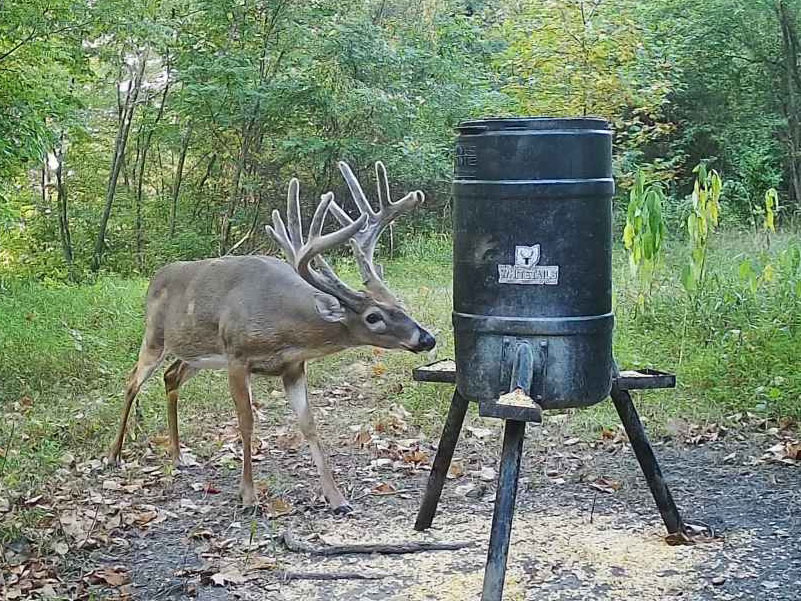Supplemental feeding is a widely discussed practice among hunters, wildlife enthusiasts, and land managers. It involves providing additional food sources to white-tailed deer to support their health, growth, and population sustainability. This guide explores the benefits, considerations, and strategies for supplemental feeding, helping you make informed decisions to optimize your white-tail population.
What is Supplemental Feeding?
Supplemental feeding is the practice of providing additional nutrients to deer beyond what is naturally available in their environment. While food plots, native browse, and mast crops are vital, supplemental feeding can bridge nutritional gaps, especially during challenging seasons like winter or periods of drought.
The goal of supplemental feeding isn’t merely to attract deer but to enhance their overall health, body condition, and antler development. However, it’s essential to approach this responsibly to avoid unintended consequences, such as overpopulation, disease transmission, or habitat degradation.

Should You Be Feeding Your Deer Year-Round?
The short answer is yes. There are many benefits to feeding your deer population year-round. Some of these benefits include helping boost antler growth of bucks and aiding nursing does with milk production. There is a science and a strategy to what time of year makes the most sense for certain nutrients, so we broke it down for you:
Spring
In spring, deer emerge from winter often malnourished and in need of recovery. Providing high-protein feeds can help bucks rebuild body mass and support antler growth. For does, it aids in milk production for fawns. Ideal nutrients during this time include proteins, minerals, and vitamins.
Summer
During summer, natural forage is typically abundant. However, bucks require additional energy to support peak antler development, and does continue to benefit from nutrient-dense feed while raising fawns. Supplemental feeding can serve as a valuable addition to natural resources, as well as food plots, especially during drought conditions.
Fall
Fall marks a critical period as deer prepare for the rut and harsh winter months. High-carbohydrate feeds, such as corn and oats, become essential for energy storage. Combining carbohydrates with protein supplements ensures deer enter winter in peak condition.
Winter
Winter is often the toughest season for deer due to limited forage availability. Supplemental feeding can provide life-saving calories and nutrients. High-fiber feeds, such as alfalfa or specially formulated deer pellets, are excellent choices to maintain digestive health and energy levels.
What States Can & Can’t You Feed Deer?
Feeding regulations vary widely across the United States. Some states prohibit supplemental feeding due to concerns about disease transmission (like Chronic Wasting Disease), while others permit it under specific conditions.
Here’s a summary:
- States That Allow Feeding: Many Southern states, including Texas and Louisiana, permit feeding with few restrictions. This practice is popular for maintaining deer populations and enhancing hunting opportunities.
- States With Restrictions: States like Michigan and Pennsylvania allow feeding but impose strict guidelines, such as prohibiting feeding during certain times of the year.
- States That Prohibit Feeding: States in the Midwest and Northeast, such as Illinois and New York, often ban feeding to minimize the spread of diseases like CWD.
Always check with your state’s wildlife agency for the most current regulations before initiating any supplemental feeding program.
What are the Best Nutrients to Feed Your White-Tail Population?
White-tailed deer thrive on a balanced diet of proteins, carbohydrates, fats, vitamins, and minerals. The ideal supplemental feed will include:
- Protein: Crucial for antler growth, muscle development, and overall health. Look for feeds with at least 16-20% protein content.
- Carbohydrates: Provide energy, especially important during fall and winter.
- Fats: An additional energy source that helps deer maintain body condition during winter.
- Calcium & Phosphorus: Essential for antler development and skeletal health.
- Vitamins & Trace Minerals: Support immune function, reproduction, and overall well-being.
Best Supplemental Feed for White-Tailed Deer
Choosing the right supplemental feed is key to a successful program. According to Thunder Ridge Outdoors, some of the best options include:
- Deer Pellets: Specially formulated to provide a balanced mix of nutrients. Look for pellets enriched with protein, minerals, and vitamins.
- Corn: A favorite among hunters for its energy content and palatability. However, corn should be used sparingly and combined with other nutrient-rich feeds.
- Soybeans: High in protein and energy, ideal for both bucks and does.
- Alfalfa: A great source of fiber and protein, helping maintain digestive health.
- Mineral Blocks or Licks: Provide essential trace minerals like calcium, phosphorus, and magnesium, promoting antler growth and overall health.

Consider Whitetail Crunch, an extruded deer feed which is high in protein for antler development.
By integrating these feeds into your deer management program and adhering to state regulations, you can support a thriving white-tail population and enhance your property’s wildlife ecosystem.
Check out Thunder Ridge Outdoors for Food Plot Seeds, Deer Lures, and Minerals
Thunder Ridge Outdoors is a leader in food plot seeds for creating the ultimate year-round deer buffet! Thunder Ridge Outdoors supports deer hunters in all aspects of sustainable and ethical food plot development. Looking to grow your white-tail deer population this year? Consider contacting a property consultant to help maximize your land and develop a strategy for bringing down your trophy buck next season.

